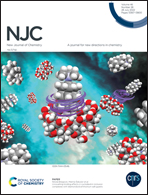One step synthesis of a bimetallic (Ni and Co) metal–organic framework for the efficient electrocatalytic oxidation of water and hydrazine†
Abstract
A series of metal–organic frameworks (MOFs) with varying Ni : Co ratios are synthesized by an easy one-step solvothermal method using trimesic acid as an organic linker. Physicochemical characterization of the synthesized MOFs was done by high-resolution transmission electron microscopy, energy dispersive X-Ray, powder X-ray diffraction, Fourier transform infrared spectroscopy, and thermogravimetric analysis, which depicts that the monometallic and bimetallic MOFs have a similar crystal structure. Among the synthesized MOFs, NiCo–MOF (1 : 1) (where the 1 : 1 ratio indicates Ni : Co ratio) exhibits efficient bifunctional electrocatalytic properties, i.e. it electrocatalytically oxidizes water and hydrazine (HZ). Electrocatalytic water oxidation leading to oxygen evolution can be exploited in the production of green hydrogen. NiCo–MOF (1 : 1) exhibits a low overpotential of 330 mV at a current density of 10 mA cm−2, a low Tafel slope of 32 mV dec−1, and high stability for water oxidation. Electrocatalytic oxidation of HZ leads to its sensitive amperometric determination in real samples. For the electrochemical detection of HZ, NiCo-MOF (1 : 1) displays a low limit of detection (1.1 μM), broad linear range (1–2000 μM) and high selectivity and stability. Thus, the present results demonstrate a new scheme to fabricate an economical and high-performance oxygen evolution catalyst and HZ sensor.



 Please wait while we load your content...
Please wait while we load your content...